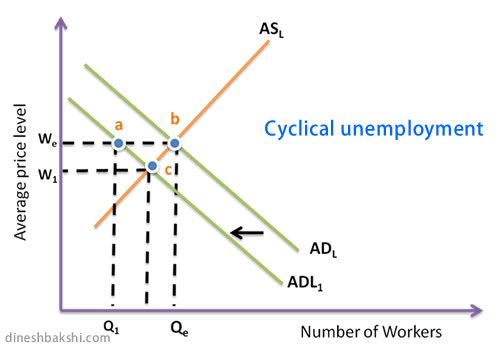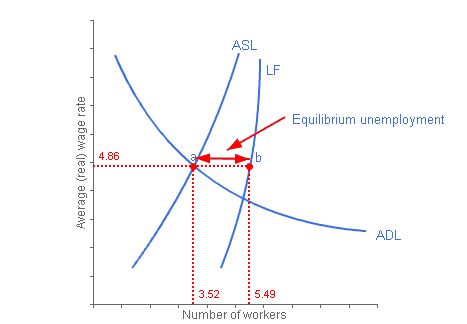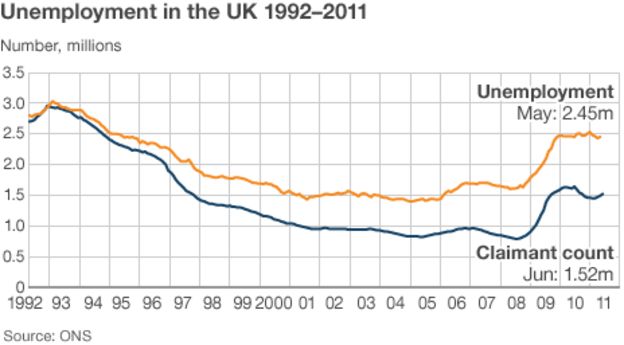Low unemployment
Another macroeconomic objective of the government is to maintain a low level of unemployment in the economy.
Unemployment refers to the number of unemployed people, defined as all people above a particular age, who are not working and who are actively looking for a job.
Underemployment refers to all people above a particular age who have part time jobs when they would prefer to have full time jobs or have jobs that do not make full use of their skills and education.
Unemployment rate= unemployed workers/total labour force
Cost of unemployment
Costs to the economy
- Unemployed labour means utilised factors of production. This will result in lower output for the economy.
- Long periods of unemployment would lead to deskilling of labour which will in return reduce potential output.
- Unemployment leads to greater disparities in the distribution of income.
Costs to the government
- Unemployed people will not pay taxes as they don’t have any running income. This will be a loss of tax revenue to the government.
- Unemployment benefits given out by the government to support the unemployed will result in extra burden on the government exchequer moreover, there is an opportunity cost involved as these funds could have been utilised for other development purposes.
Costs to society
- Higher unemployment leads to increased crime and vandalism. Moreover, there is a cost to the government of dealing with social problems resulting due to unemployment
Costs to individuals
- There are personal costs for the unemployed in terms of stress-related illness and family problems (family breakdown) caused by the strain of being unemployed.
- In order to meet daily expenses, an unemployed person may result in increased indebtedness
Watch a Video
Types and causes of Unemployment
Disequilibrium Unemployment
Cyclical or Demand Deficient unemployment
Cyclical unemployment exists when individuals lose their jobs as a result of a fall in aggregate demand (AD). The fall in AD, in the economy, results in the fall in real output and thus unemployment. It is called also known as demand deficient or Keynesian unemployment.
Cyclical unemployment through a diagram
As we can see in the AD/AS diagram, the fall in AD to AD1 will result in a fall in the Real output (Y1).
This will force the firms to reduce their output and hence reduce their workforce from ADL to ADL1. However, due to ‘wage stickiness’ it is less likely that real wages will fall (as seen in the labour diagram). Therefore, the wages instead of coming down to W1 will remain at We. This will create a surplus situation where the aggregate demand for labour will be at ‘a’ and the aggregate supply of labour will be ‘b’.


Wage stickiness: The firms may not be able to reduce the wages may be as a result of the following reasons:
- They don’t want to create discontent among the workers by reducing their wages
- Trade unions may not allow the wages to go down.
- Labour contract may deter the firms to reduce the wages.
Equilibrium Unemployment
Structural unemployment
Structural unemployment occurs when certain industries decline because of long term changes in market conditions. These structural changes in the economy might lead to fall in demand for certain sectors of the economy. This is usually common in developing countries where primary sector generally reduces in size and secondary sector and tertiary sector might gain more importance. Change in technology is also one of the major reasons for structural unemployment, whereby certain kind of jobs become obsolete. Changes in consumer taste or preference may also be a cause of structural unemployment
Structural unemployment may worsen if there is
- Occupational immobility occurs when there are barriers to the mobility of labour between different industries and occupations.
- Geographical immobility exists when there are barriers to people moving from one area to another to find work.
Frictional Unemployment
Frictional unemployment occurs when people leave their jobs and are unemployed while they are looking for a new job, or just having a break from working.
Seasonal Unemployment
Unemployment attributable to relatively regular and predictable declines in particular industries or occupations over the course of a year, often corresponding with the climatic seasons.
Equilibrium unemployment through a diagram
Here, we can see what is called equilibrium unemployment represented by the arrows between point a and point b. Equilibrium unemployment is the term which means the situation is that the labor market is in equilibrium but there are still people who are not at work (represented by the arrows between points a and b.)
This is what would realistically be considered as full employment, since there will always be people who are unwilling or unable to take available jobs, causing the official rate of unemployment (calclated by) to be above zero, which is not a realistic reachable goal.

Watch a Video
Measures to reduce unemployment
Cyclical unemployment
Use expansionary demand side policies to increase AD in the economy i.e. fiscal and monetary policy
Structural unemployment
- Market Oriented measures such as letting the wages fall in depressed areas, lowering unemployment benefits, reducing workers’ job security, lowering income tax.
- Interventionist measures include setting up training facilities for workers to upgrade their skills, encourage geographical mobility, providing job information, offering incentives to firms that hire in depressed areas.
Frictional & Seasonal unemployment
- Measures include reducing the time that a worker spends in between jobs and improving information flows between workers.
- Market Oriented measures such as lowering unemployment benefits, lowering income tax.
- Interventionist measures include setting up jobs centres, employment agencies.
Which are the most effective policies?
It depends upon the type of unemployment involved.
However, the types of equilibrium unemployment (frictional, structural and seasonal) may ONLY be cured by supply-side policies.
Demand-deficient unemployment may be cured by expansionary demand-side policies.
The use of demand-side policies may have bad effects elsewhere in the economy. For example, if interest rates are lowered, this may lead to inflation and a fall in the external value of the currency (the exchange rate). Furthermore, there is no guarantee that expansionary monetary policy will be effective in raising AD. If consumer and business expectations about the future are pessimistic, then lower interest rates may not necessarily lead to increased AD.
Claimant count
Claimant count is an economic indicator for the United Kingdom that measures unemployment.
This data is provided by the United Kingdom's Office of National Statistics (ONS), the Claimant Count measures the number of people seeking unemployment benefits while they are seeking for work. It is reported as a percentage change from previous month.






